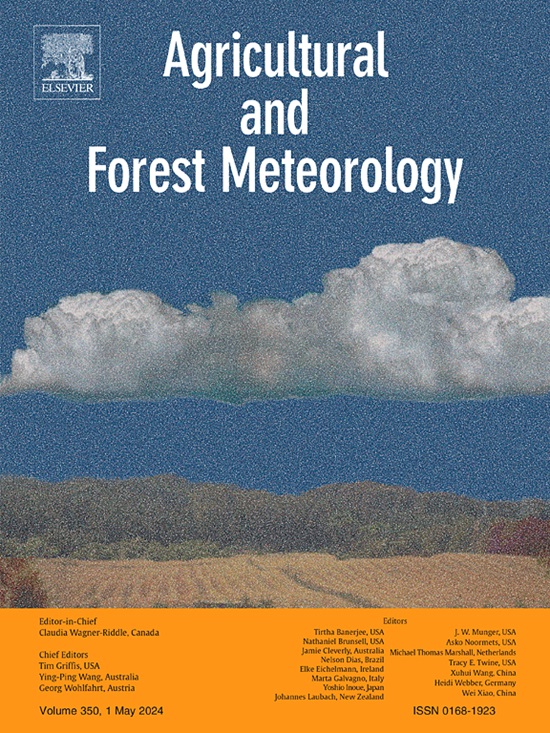The impact of wildfire on the land surface parameters of a semi-arid grassland in the southwestern U.S.
IF 5.6
1区 农林科学
Q1 AGRONOMY
引用次数: 0
Abstract
Just before the installation of a long-term energy/carbon flux tower site at the 10,000-acre Appleton-Whittle Research Ranch in southern Arizona, a wildfire burned nearly 90 % of this semi-arid grassland area in the region and there was little vegetation remaining on the surface. Wildfires in this region occur roughly every 7 - 15 years. The establishment of the site allowed for the determination of recovery time for this semi-arid grassland ecosystem. We examined how the wildfire altered the land surface characteristics such as broadband and photosynthetically active radiation (PAR) albedo, surface roughness, and the seasonal net ecosystem exchange. This information was also used to determine the amount of time it took this ecosystem to recover back to a quasi-baseline state. We found that it took approximately 3 years for the surface roughness to increase from 0.04 to 0.12 m, and then stay near that level in the following years. The monsoon season (July - September) net ecosystem exchange (NEE) was positive (source) for two years following the wildfire and did not become a significant net carbon sink until 2005. The ecosystem recovery from this wildfire event may have occurred sooner but the accumulated rainfall for the 2 years following the fire were both well below the 20-year average of 254 mm. We were also able to determine that immediately after the wildfire, the soil shortwave and PAR albedo was 0.20 and 0.13, respectively. However, with the onset of the monsoon and rainfall, both the shortwave and PAR albedos decreased to 0.10 and 0.07, respectively. The albedos reverted to the original values after several days of no additional rainfall.
野火对美国西南部半干旱草原地表参数的影响
就在亚利桑那州南部占地1万英亩的阿普尔顿-惠特尔研究牧场安装一个长期能源/碳通量塔之前,一场野火烧毁了该地区近90%的半干旱草地,地面上几乎没有植被。该地区的野火大约每7 - 15年发生一次。立地的建立为确定半干旱草原生态系统恢复时间提供了依据。我们研究了野火如何改变陆地表面特征,如宽带和光合有效辐射(PAR)反照率、表面粗糙度和季节性净生态系统交换。这些信息还用于确定生态系统恢复到准基线状态所需的时间。我们发现,表面粗糙度从0.04 m增加到0.12 m大约需要3年的时间,然后在接下来的几年中保持在该水平附近。季风季节(7 - 9月)净生态系统交换(NEE)在野火发生后的两年内为正(源),直到2005年才成为重要的净碳汇。这次野火事件可能会更快地恢复生态系统,但火灾后两年的累积降雨量都远低于20年平均降雨量254毫米。我们还能够确定,在野火发生后,土壤短波和PAR反照率分别为0.20和0.13。而随着季风和降雨的来临,短波反照率和PAR反照率分别降至0.10和0.07。在几天没有额外降雨后,反照率恢复到原来的值。
本文章由计算机程序翻译,如有差异,请以英文原文为准。
求助全文
约1分钟内获得全文
求助全文
来源期刊
CiteScore
10.30
自引率
9.70%
发文量
415
审稿时长
69 days
期刊介绍:
Agricultural and Forest Meteorology is an international journal for the publication of original articles and reviews on the inter-relationship between meteorology, agriculture, forestry, and natural ecosystems. Emphasis is on basic and applied scientific research relevant to practical problems in the field of plant and soil sciences, ecology and biogeochemistry as affected by weather as well as climate variability and change. Theoretical models should be tested against experimental data. Articles must appeal to an international audience. Special issues devoted to single topics are also published.
Typical topics include canopy micrometeorology (e.g. canopy radiation transfer, turbulence near the ground, evapotranspiration, energy balance, fluxes of trace gases), micrometeorological instrumentation (e.g., sensors for trace gases, flux measurement instruments, radiation measurement techniques), aerobiology (e.g. the dispersion of pollen, spores, insects and pesticides), biometeorology (e.g. the effect of weather and climate on plant distribution, crop yield, water-use efficiency, and plant phenology), forest-fire/weather interactions, and feedbacks from vegetation to weather and the climate system.

 求助内容:
求助内容: 应助结果提醒方式:
应助结果提醒方式:


